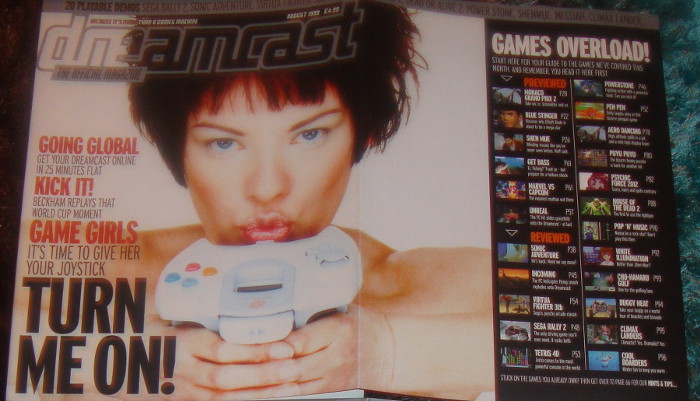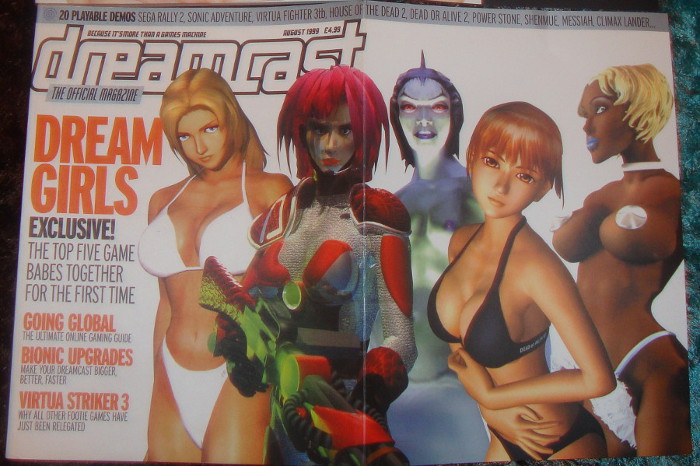|
From Dummy Issues to
Official
Dreamcast Magazines
|
| It’s
surprising what you discover if you take a little time to look around
as we
did with our videogame
magazine
collection. It’s
also even more
surprising if you happen to come across a rather rare dummy issue of a
Dreamcast Magazine. And we don’t mean the issue zero or
preview issues that are floating around the web in a pretty poorly
scanned fashion. We’re talking about the blueprint of a
magazine that would come away with the official Sega Dreamcast magazine
licence. This was a fascinating discovery and we felt
compelled to learn more, so who better to ask than Mark Higham, the
editor-in-chief and the man who was brought in to produce the Official
Dreamcast Magazine for Dennis Publishing. |
 |
| The fold out cover of the Official
Dreamcast Magazine dummy issue, featuring the familiar Dreamcast cover
girl who would go on to dorn the covers of the ‘preview
issue’ and the ‘Special
issue’ |
|
As suspected,
these dummy issues were indeed produced to tender for the official
Dreamcast magazine licence. So, just how did Mark and Dennis Publishing
win that much sought after licence, especially with Future Publishing
(who were publishing the Official
Playstation Magazine) and EMAP (the
previous holder of the official Sega licence with Sega Magazine/Sega
Saturn Magazine) both in the running?
The first thing you will notice about the August 1999 dummy issue of
Dreamcast: The
Official Magazine is the use of two alternate cover
editions. “The alternate covers were simply a way of showing
Sega the kinds of options we envisaged,” explained Mark. Also
of note is the thick bookazine production values used. “We
went for very high production values in order to demonstrate what we
could with the title - that's why the paper is so thick,”
Mark added. “But as it was just a dummy issue it was only
ever an example of the kind of content we could produce and was never
intended to be a full magazine - it would have been far too expensive
to produce an entire issue. Instead, we produced about 64 pages and
then duplicated that number of pages to make it up to the kind of issue
size that the final mag would be.”
|
As the pull out
front cover opens, the content of the demo disc is revealed, with the likes
of Sega Rally 2, Virtua Fighter 3tb, Power Stone and Sonic Adventure,
and then there is Mark’s editorial. The key principles that
Mark discussed in the editorial were “Dreamcast gaming is
cool,” that the console had a “sense of
community,” and emphasized the magazine’s
“passion for games...” “We believe that
with this title, GAMES MAGAZINES HAVE GROWN UP,” commented
Mark as he rounded off his editorial. “The Dreamcast
represents the future of console gaming. This magazine represents the
future of games magazines.”
Content wise, Official Dreamcast
Magazine’s dummy issue
seemed to offer the usual news, previews, reviews and features, but
there were little differences. Obviously, the lifestyle features of
videogaming fashion stood out as something quite unique within the
pages of a gaming magazine. Also in this issue was an interview with
the crew of sci-fi comedy Red Dwarf
(with their take on the Dreamcast and the games), a Dreamcast online
feature, a
readers’ gaming night feature, an online interview with John
Romero and much more. Reviews wise, Sonic
Adventure led the way with a
perfect 6/6 rating. A 6 out of 6 rating scale? “We initially
selected marks out of six because it felt closer to a lifestyle
magazine approach rather than a games magazine approach,”
stated Mark. |
 |
| The top five game babes gather for the
alternate cover fold out spread |
|
Rather
surprisingly to a lot of people, Sega chose Dennis
Publishing’s offering over the other offerings.
“Sega were keen to pitch Dreamcast as a mass market machine
aimed at the general public rather than at hardcore gamers,”
recalled Mark. “What they liked about our offering was that
it felt more like a lifestyle magazine than a gaming magazine. I'd
argue they were wrong in this approach. They really played up the idea
that you could potentially play against six billion players worldwide -
of course, the reality was very different and the hardware simply
wasn't up to the task. I went to Marseilles for the creation of the
launch ad which was very clearly aimed at a mass market.”
With the official Dreamcast licence in the bag, Mark and his team began
work on a preview issue, a 28-page edition that would give the public a
taste of what to expect from the magazine. While some things were
familiar (the Dreamcast cover girl and other features re-appeared in
re-worked form), some
things had changed. “There were minor tweaks introduced as part
of the review process after we evaluated the preview issue,”
stated Mark. “It was felt that marks out of ten gave us more
scope to distinguish the stronger games as over the longer term we'd
have had too many games with a similar score.” As for the
front cover, the main change was the Official
Dreamcast Magazine logo.
“I remember we felt that the official Dreamcast logo didn't
work particularly well as a magazine logo,” commented Mark,
“but as we had the official licence it would have been
ridiculous not to use the official logo on the launch
edition.”
|
Expanding
on the ‘preview issue’, the ODM team produced a ‘Special issue’, dated October 1999. Coming in at
132 pages and packed full of similar content as the dummy issue, this
was effectively the magazine’s first proper issue to go on sale.
The only thing left to sort out was the covermount DreamOn disc, which
contained all the playable demos, but just how important was that
covermount disc? “It was absolutely crucial,” commented
Mark, “as indeed it was with any console magazines back then. It
was always the demos that sold the issue and that was what ultimately
distinguished the official mag from the competition. The most important
thing was that demos had to be playable. Many gamers were happy to
stick just with the demos and felt it was a cheap alternative to buying
full games, which it was.”
Official Dreamcast
Magazine went on to become the most successful title out of the
main four Dreamcast magazines, but all good things come to an end and
the Dreamcast and its accompanying official magazine were no exception.
“Sony announced the PlayStation [2] shortly before Dreamcast was
launched,” added Mark. “It was clear from that point that
the PlayStation [2] would be a superior machine. Dennis Publishing had
been desperate to win the official Dreamcast launch until that point.
It's a shame that the console itself never lived up to expectations,
particularly as far as multi-player gaming went. However, there were
still some excellent games for it right from the start.”
|
| Notes: |
Special thanks to Martyn
Chudley for preserving these dummy issues in an immaculate condition
for so long which enabled us to experience a piece
of videogaming magazine history.
|
All the intellectual property rights related to the works presented on this site belong to their respective owners.
This site is strictly created for the purpose of preservation and education.
Follow us on Mastodon to get the latest updates as they go live as well as daily magazine articles:
 |
|
|